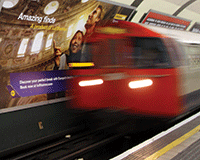It is perhaps apt that there is a “secret” dining club that organises gastronomic events along the route of the “Ginger Line” – the nickname for the overground railway that circumnavigates London.
The line gets its name from the colour used to depict it on the London tube map, but with all the excitement that is being generated by the advent of Crossrail, the effect of London’s improved overground line has been rather overlooked.
Foodies can Google “Ginger Line dining” to find out more about the nomadic restaurant club, but property developers and investors will probably be more excited about the effect that the recently joined-up rail link is having on residential prices – particularly around south-east London.
It is emphatically changing the attitudes of home buyers because it provides quick access to key workplaces in the capital and is opening up new development potential in areas that had previously underperformed because the lack of a Tube station had downgraded them in buyers’ eyes.
The effect began to be felt in 2011 when the final two stations on the East London line section were completed. By linking Dalston Junction to Highbury & Islington, the circle was more or less complete, and the addition of Shoreditch High Street station accelerated the line’s new credentials.
Crucially, the line runs through Canada Water and offers a route to work for Canary Wharf and the Docklands area. Similarly, being able to connect into hubs such as London Bridge, Charing Cross and Victoria is showing home buyers that the Tube is not the only rail alternative in the capital.
The journey from Peckham Rye to either London Bridge or Canada Water is 10 minutes.
The simple act of including the overground line on the Tube map has radically transformed awareness and usage. This has had a hugely positive effect, particularly noticeable in south-east London around stations such as Peckham Rye, Denmark Hill and New Cross Gate.
Zoopla reports that Peckham house prices have risen by around 10% in the past year, while for better properties that figure is probably closer to 20%. By way of comparison, CBRE has estimated that Crossrail will drive London residential prices up by around 13% on average, with uplifts in areas such as Farringdon possibly reaching 25%.
For developers looking to capitalise on the Ginger Line, the challenge now is to try and find sites or existing buildings that can be redeveloped or adapted to produce the type of product that home buyers want. The line runs through built-up, mature areas, so it requires a creative approach to unlock sites.
A key aspect of this is finding sites that have fallen out of commercial use or have been subject to urban decay. Bringing such sites forward has to balance the intrinsic costs with the value of the final product. The type of residential development we are talking about are homes for “working Londoners” that typically command capital values of around £500-£600 per sq ft. As ever, development has to factor the final sale price into costs but it can be done if you have the expertise and can perhaps incorporate a commercial element such as a food store.
Development around the “Ginger Line” may not be as dramatic as tower blocks on the Thames or the major schemes planned around key Crossrail interchanges, but it can play a significant role in providing the homes that London needs in locations that suit commuters and at prices within their reach.
Charles Sandy is director of Charter Land











